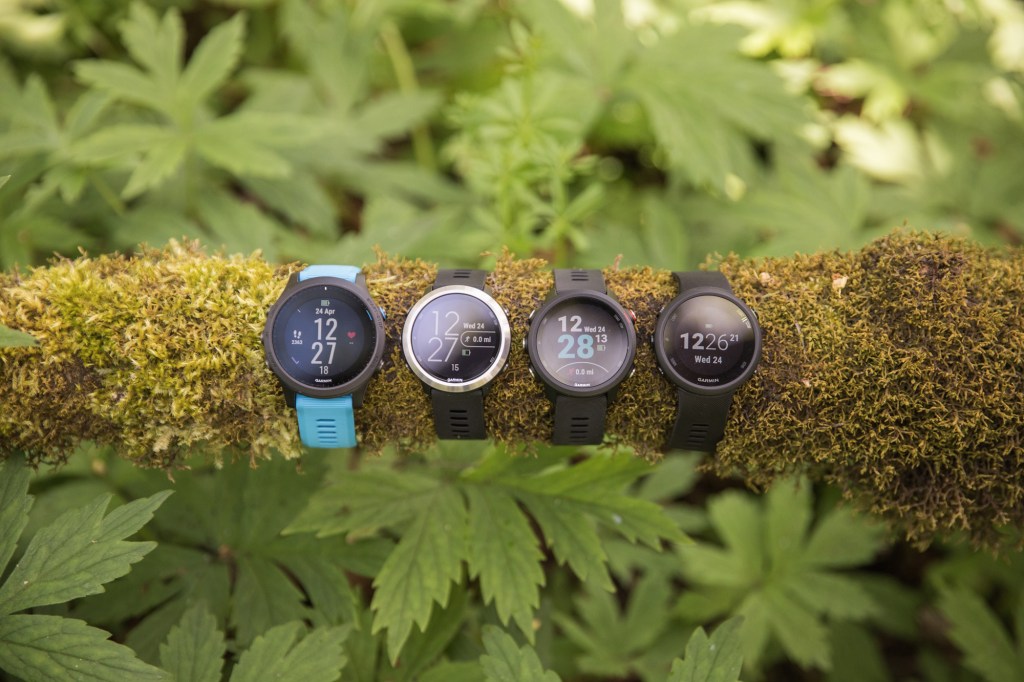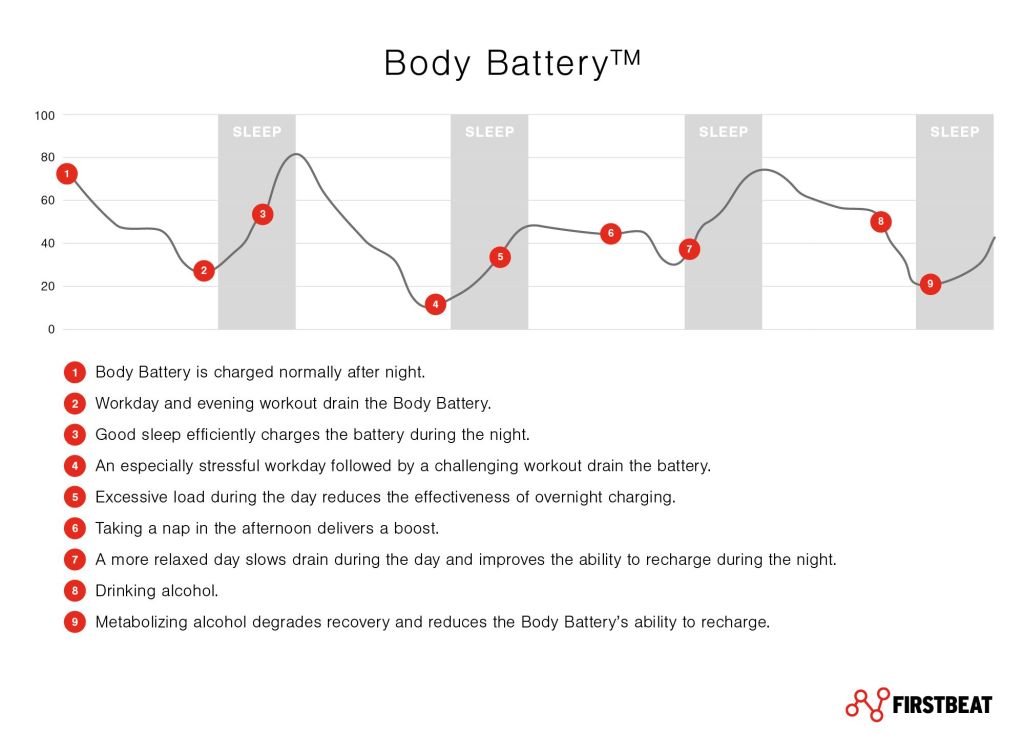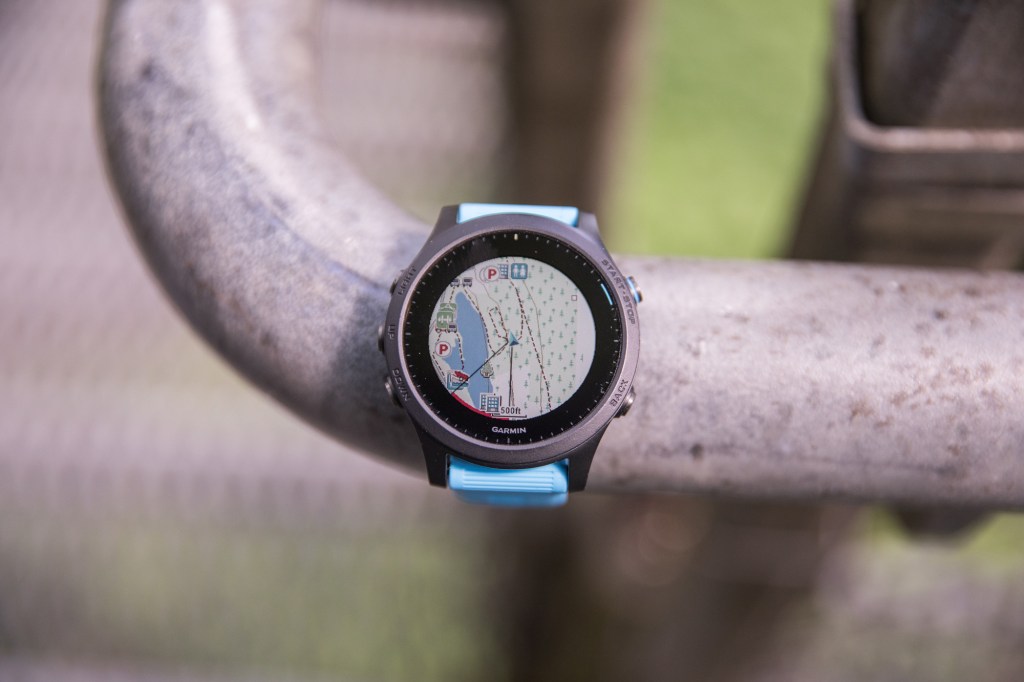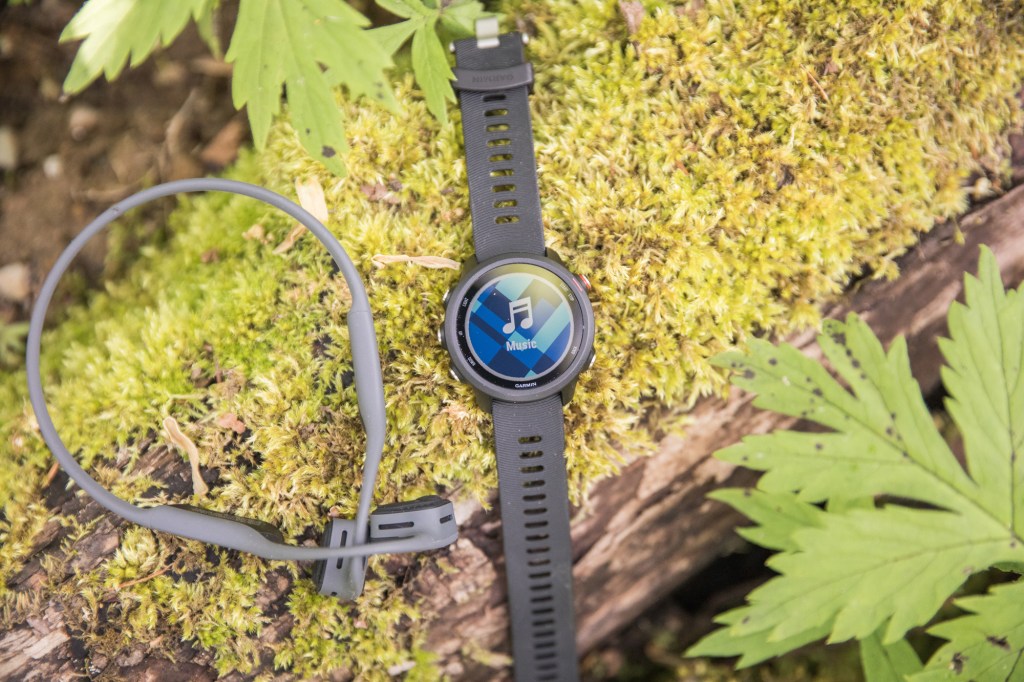A version of this story appeared in the fall 2019 issue of Uncommon Path.
Earlier this year, Garmin announced the launch of several new GPS watches—Forerunner 945, Forerunner 245 (including 245 Music version) and Forerunner 45 (including 45S, a more compact version). They signify the first update to the Forerunner line in more than a year, and the first upgrade to its flagship model (Forerunner 935) in more than two years.
The Forerunner series is designed for athletes who want to evaluate their training with detailed metrics, tracking and built-in data analysis. It’s geared especially toward runners. The watches are designed to be worn during any workout, as well as all day (and even night) to help you get a holistic understanding of your fitness—all grounded in robust physiological data. Adaptive training plans and advice, based on your workout data, are baked in to help you optimize your performance.
In this article, we’ll break down what’s new for Forerunner, how these watches compare to their predecessors, and how all watches in the Forerunner line compare to each other (and, in some cases, to closely related watches like the Garmin Fenix 5 Plus).

From left to right: The Garmin Forerunner 945, 645, 245 and 45 watches (blue band available with 945 Tri-Bundle).
What’s New: A High-Level Look
If you’ve kept an eye on the features Garmin has been introducing to some of its other watches in the past year, you probably won’t be surprised to learn that the new, top-of-the-line Forerunner 945 has many of these features, too. Some of these include:
- Music storage (up to 1,000 songs in MP3 or AAC format—notably, twice the storage capacity of any other Garmin watch, including Fenix 5 Plus or Forerunner 645 Music), as well as music streaming from selected services like Spotify Premium and Deezer, with the possibility of others to be added in the future.
- Preloaded, full-color, routable maps with Trendline ™ popularity routing (Forerunner 945 is the first and only Forerunner to have this feature)
- Garmin Pay™ contactless payments
- Pulse oximeter (blood oxygen saturation level sensor)
- Improved multi-satellite network capability
Of the above features, the 245/245 Music gets a pulse oximeter as well. For improved accuracy in tracking, all the new watches also receive multi-satellite network upgrades (adding Galileo network support to the 235’s existing support for GPS and GLONASS, and to the 35’s existing support for GPS). Additionally, the 245 Music has space for up to 500 songs, plus streaming from the same bevy of selected services.
(For more in-depth details on any of the above features, check out our rundown from when the Fenix 5 Plus line introduced them last June.)
New for Forerunner 945 and 245 is an extra 12 hours of battery life (in GPS mode without music) over their predecessors. Forerunner 45 maintains the same battery life as Forerunner 35—13 hours in GPS mode—but gets a nice upgrade to a full-color display.

The Body Battery™ energy-monitoring feature on the Garmin Forerunner 245.
New for Forerunner 945 only is heat and altitude acclimatization data. Forerunner 945 also gets upgraded physiological features, including an improved race predictor, training effect labels and training load focus. Both the new Forerunner 945 and 245 get an improved race predictor, and all new Forerunner watches benefit from an improved VO2 max estimate and inclusion of the Body Battery™ energy-monitoring feature. We’ll explain many of these features more in-depth later in this article.
Additionally, two features that are a first for any Garmin watch REI has carried are Assistance and Incident Detection, which notify your emergency contacts in case you run (or ride) into trouble. And they’re available on all the new Forerunners—945, 245/245 Music and 45/45S—rather than just the top-of-the-line model.
What’s Staying the Same
Before we get into the nitty gritty of all the new features, we’ll quickly run down what hasn’t changed—including some of the awesome, existing functionality you may not yet know about if you’re totally new to the Forerunner line.
All Forerunner watches have the following features:
- Built-in GPS for accurate distance and pace data
- Elevate™ wrist-based heart rate tracking, including your average resting heart rate over the past 7 days
- All-day activity tracking, including steps, calories and movement reminders
- VO2 max estimate (with improved accuracy over previous models)
- LiveTrack™, which lets friends and family follow along with your race or workout in real time
- Music controls (for listening to tunes on your paired smartphone with any Forerunner, or for listening to tunes streamed directly through your Forerunner 945, 645 Music or 245 Music)
- Garmin Connect™ app integration
- Smart notifications
- Automatic data uploads and software updates
The plastic housing on the new Forerunners also remains the same as past Forerunners. It’s a less rugged housing than the premium materials used in the more expensive Garmin Fenix line (even those not equipped with Sapphire glass), making the faces on these ever-so-slightly more susceptible to scratches if you’re planning to take your watch on some especially wild adventures. However, this casing also keeps the Forerunner watches slimmer, lighter-weight and more compact than Fenix watches—even though Forerunner 945 boasts much of the same functionality (and then some!) and battery life as Fenix 5 Plus.
Comparing Forerunner Models: An Overview
The Forerunner line is designed to satisfy athlete needs at every level and budget.
To recap, the new Forerunner watches include:
- Forerunner 945 (new version of the 935), also available in 945 Tri-Bundle (comes with HRM-Swim and HRM-Tri chest straps)
- Forerunner 245 (new version of the 235) and 245 Music (same as 245, plus music storage/streaming)
- Forerunner 45 (new version of the 35) and 45S (same as 45; sized for smaller wrists)

The Garmin Forerunner 645 and 245 side by side.
Note that several existing Forerunner watches will remain in the line, unchanged at this point:
- Forerunner 645 and 645 Music
- Forerunner 735XT, also available in 735XT Tri-Bundle (comes with HRM-Swim and HRM-Tri chest straps) and 735XT Run-Bundle (comes with HRM-Run chest strap)
Check out this at-a-glance comparison of key differentiators between all versions of the 2019 Garmin Forerunner line, and then read on for more in-depth information so you can decide which Forerunner is best for you.
Comparing the watches in the Garmin Forerunner series:
| 945 | 645
Music |
645 | 245 Music | 245 | 735 XT | 45 | 45S | |
| Price | $600 | $450 | $400 | $350 | $300 | $350 | $200 | $200 |
| Face Size | 47mm | 42.5mm | 42.5mm | 43mm | 43mm | 44.5mm | 42mm | 40mm |
| Battery Life on GPS Mode* | 36 hrs. (10 hrs. with Music on) | 14 hrs. (5 hrs. with Music on) | 14 hrs. | 24 hrs. (6 hrs. with Music on) | 24 hrs. | 14 hrs. | 13 hrs. | 13 hrs. |
| Incident Detection/ Assistance |
Yes | No | No | Yes | Yes | No | Yes | Yes |
| Music Storage | 1,000 songs | 500 songs | None | 500 Songs | None | None | None | None |
| Maps | Yes | No | No | No | No | No | No | No |
| Garmin Pay | Yes | Yes | Yes | No | No | No | No | No |
| Pulse Oximeter | Yes | No | No | Yes | Yes | No | No | No |
| Satellite Reception | GPS, Galileo & GLONASS | GPS & Glonass | GPS & Glonass | GPS, Galileo & GLONASS | GPS, Galileo & GLONASS | GPS & Glonass | GPS, Galileo & GLONASS | GPS, Galileo & GLONASS |
Assistance and Incident Detection
Available on: Forerunner 945, 245/245 Music and 45/45S
Worried about safety on your solo workouts? These tracking features let you pair your Forerunner with a compatible smartphone and, in case of an emergency, alert up to three contacts via buttons on your watch that you need help. These features were previously only available on Garmin Edge bike computers and on the vivoactive 3 Music (Verizon) watch that debuted earlier this year (available only from Verizon).
After setting up your emergency contacts and configuring these features through the Garmin Connect™ app, they are easy to activate or deactivate on the watch itself. The Assistance feature lets you quickly trigger a text message (non-customizable) with your GPS location to your emergency contacts. It also automatically generates a LiveTrack session and shares the URL with your contacts.
Incident Detection uses complex algorithms to detect if you’ve crashed on your bike or collapsed during a walk or run, then automatically alerts your contacts (again, via text with GPS location, plus a LiveTrack URL) on your behalf. Even if you’re unconscious on the ground, your watch is capable of automatically texting an alert with your GPS location to friends or family. (Don’t worry—if you don’t actually need their help, you’ll have a 15-second window to cancel the automated message before it sends—or easily trigger a “Never mind, I’m fine!” message afterward.)
The fine print: Both of these features require pairing the watch with a Bluetooth®-enabled iOS or Android smartphone, and unlike the functionality on the Verizon edition of vivoactive 3 Music, you must also keep your phone within Bluetooth range of your watch for these features to work. Your paired smartphone must have a data plan (with any provider), and these features will only work where your phone has reception. Incident Detection does not work during indoor activities.
Improved Firstbeat Features, Including Training Load Focus and Training Effect Labels
Available on: Forerunner 945
Ever heard of Firstbeat? It’s a third-party analytics engine that provides many of the physiological features for fitness trackers like Garmin vivosmart 4 (as well as many wearables from other manufacturers like Suunto, Sony, Huawei, Montblanc and others). Its algorithms have improved accuracy for VO2 max estimate and race predictor. (The latter uses your watch data to estimate what times you’re capable of running in a 5K, 10K, half marathon and full marathon. The more hard workouts you do with the watch, the more accurate its predictions can be.)
Firstbeat algorithms also drive a number of other new features, including two being introduced to Forerunner 945:
- Training Load Focus—creates a bar graph of your training data, dividing it into three categories (low aerobic, high aerobic and anaerobic), then for optimal performance, advises on whether you’re spending too much or too little time training in each category.
- Training Effect Labels—creates color-coded labels for your workouts (teal for recovery/base training, orange for tempo/threshold workouts and purple for anaerobic/sprints) to help you see each workout’s benefits at a glance.
Body Battery™
Available on: Forerunner 945, 245/245 Music and 45/45S
Fans of the Body Battery function (also based on Firstbeat algorithms) that Garmin introduced with vivosmart 4 will be delighted to know all the new Forerunner watches have this functionality, too. Supplementing the watches’ existing 24/7 stress-tracking functionality, Body Battery uses heart-rate variability (HRV) data and factors like sleep, stress and physical activity to estimate your energy reserves at any given time.
This is presented on the watch as a number (0-100)—the idea being that you can use this data to build awareness about the factors that zap your energy levels, and those that recharge your batteries. It can also help you optimize the times of day that you choose to tackle more challenging workouts or mental challenges.

Photo Courtesy: Firstbeat Technologies
Heat and Altitude Acclimatization
Available on: Forerunner 945
If you’ve ever tried to run in the high alpine after coming from sea level, you know that altitude acclimatization is no joke. Similarly, let’s say you spend all winter training in the snow, then travel to the desert for a hot race. Our bodies take time to adjust to challenging environmental factors like heat and altitude—and for the first time, Forerunner 945 can take both of those factors into consideration when calculating your physiological data.
It does so in two ways. Thanks yet again to Firstbeat algorithms, Forerunner 945 provides you with measurements at any given time for your acclimatization to heat (as a percentage on a scale of 0-100) and altitude (as a number of feet above sea level to which your body has adapted). The display also lets you know which direction you’re trending and how rapidly you’re acclimating.
The other way this works is by also taking heat and altitude into account when calculating figures like your VO2 max estimate—ultimately leading to more accurate data.
Improved Garmin Coach
Available on: All Garmin Forerunner, Fenix and vivoactive watches
Garmin Coach, an existing feature on Forerunner 645 (including 645 Music) and Forerunner 935, receives some welcome upgrades—and is now also available on the more entry-level Forerunners (245/245 Music and 45/45S) for the first time. (Forerunner 35 and 235 don’t support Garmin Coach.) This app lets runners access free, adaptive training plans that sync to your watch and adjust automatically based on your performance in workouts along the way. (Note that this feature is also available on Garmin Fenix and vivoactive watches.)
In the past, Garmin Coach has been very beginner-oriented—supporting 5K training plans only, and race-pace training of 8:00/mile or slower. The new and improved version adds 10K and half-marathon training plans, plus race-pace training up to 7:00/mile. This update will also trickle out to all existing watches with Garmin Coach, including Forerunner 645, Forerunner 935, vivoactive 3 and Fenix watches.
The Bottom Line: Which Forerunner Should I Get?
Choose Forerunner 945 ($600) if you’re an athlete of any kind who wants access to extensive training, performance and physiological fitness data in a full-featured GPS powerhouse complete with built-in color maps and music storage/streaming. Its whopping 36-hour battery life on GPS mode is a huge improvement over 935 (24-hour battery life on GPS mode). With music and GPS on, it has nearly twice the battery life of any other music-equipped Forerunner (245 Music or 645 Music). This makes it ideal for dedicated endurance runners, cyclists or triathletes who need a watch that won’t die in the middle of their workouts—or for those who want to leave their phones behind when they train. Additionally, if heat and altitude are concerns, or if you swim in open water, Forerunner 945 is the watch for you.
*For swimmers and triathletes, note that this watch is also available in a Forerunner 945 Tri-Bundle ($750), which includes 2 pool- and open-water-friendly chest straps: the HRM-Tri and the HRM-Swim. (The wrist-based heart rate monitor on the watch itself won’t work underwater.) Wearing a chest strap also allows you to access advanced features like lactate threshold and the HRV (heart rate variability) stress test.

The built-in color map capability on the Garmin Forerunner 945 watch.
Forerunner 645/645 Music ($400/450) came out last year, so doesn’t benefit from all of the new features discussed in this article (such as Assistance, Incident Detection, Body Battery™ and others), but it’s still a solid higher-end choice for runners, cyclists, pool swimmers, hikers and more. Some of the features it offers that Forerunner 245 lacks are Garmin Pay™ contactless payments, a built-in altimeter and a gyroscope for better gym-activity performance—so if these are of importance to you, the 645 may be your best bet. It also comes with a metal bezel that gives it a bit nicer look and feel than the plastic bezels on all other Forerunner models.
Choose Forerunner 245/245 Music ($300/350) if you’re excited about the latest and greatest Forerunner features outlined in this article, but want to save a few hundred bucks by forgoing maps, Garmin Pay™, an altimeter, several physiological features and the most impressive battery life. (Note that what this watch offers—24 hours on GPS mode and 6 hours on GPS mode with music on—is still plenty for most folks.) Compared to Forerunner 235, it offers a more impressive spread of Firstbeat features to steer your training, a higher-resolution display, more configurable fields, plus—of course—the Music version option for those who want to run phone- or device-free. Particularly for those who don’t mind carrying another device during their workouts (so may have less of a need for on-watch music, maps or payments), the 245, at $50 less than the 245 Music, is a great, wallet-friendly choice.

The Garmin Forerunner 245 Music has music storage for up to 500 songs, allowing you to run phone/device free with Bluetooth headphones.
When it was first released three years ago, Forerunner 735XT ($350) offered many functionalities above and beyond the other midrange Forerunner (235)—most especially multisport capabilities geared toward triathletes, including compatibility with the HRM-Tri and HRM-Swim chest straps. It’s still the most affordable Forerunner that can handle open-water swimming (Forerunner 645 and 245 only support pool swimming). Otherwise, with so many new features being introduced in Forerunner 245 at the same price point or even less, there probably won’t be a huge incentive for most people to buy the 735XT unless it’s on sale.
Choose Forerunner 45 ($200) if you’re a runner or cyclist looking for an affordable, entry-level GPS watch with everyday wellness/stress tracking, plus a few key nice-to-haves beyond the standard fare—but not so much training data that you feel overwhelmed. Most notably, it features wrist-based heart rate, VO2 max estimate and many improvements over Forerunner 35, including a full-color display with customizable watch faces, Assistance and Incident Detection, Garmin Coach, stress tracking and Body Battery™.
With its compact 40mm-diameter face and shorter watch band, Forerunner 45S ($200) is simply a smaller version of the 45, which has a 42mm face. (In terms of price and functionally, including battery life, the 45 and 45S are identical.) It’s perfect for those with smaller wrists, or who simply prefer a less bulky feel. In the grand scheme of GPS watches, the 45 is already a slim, sleek option that could easily be mistaken for a regular, everyday watch rather than the powerful, GPS-capable tool it is.
